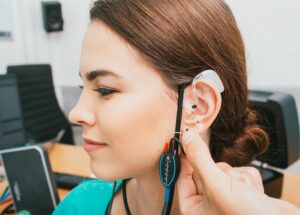Prior to the hearing aid fitting, the patient and audiologist will select the hearing aids. This involves careful consideration of the patient’s style preference, hearing lifestyle, budget and desire for additional features. Once selected, the hearing aid will be ordered and the patient will return to the clinic for the hearing aid fitting.
During the hearing instrument fitting, a computer program is used to set the audio parameters needed to improve speech. This information is obtained from the patient’s hearing tests. In order to confirm that these settings are correct, a Real Ear Measure will be performed.

A Real Ear Measure determines how loud sounds are in the patient’s ear canal, after they have been processed by the hearing aid. The patient must sit still while a tube is placed in their ear canal. This tube is connected to a microphone that sits outside the ear. This microphone measures how loud sounds are before they enter the hearing aid, in order to compare. The patient’s hearing aid will then be placed in their ear carefully so as not to dislodge the tube. A series of tones will be played, ranging in pitch from soft to very loud. The results of this test are able to confirm if the soft sounds have been adequately amplified and if the very loud sounds have been reduced so they don’t exceed the patient’s discomfort level.
Once the hearing aid has been fitted, proper care and hearing aid maintenance will be reviewed with the patient. The audiologist will demonstrate how to safely insert and remove the hearing aid from the ear as well as how to change the battery.
The hearing aid should be cleaned daily with a soft, dry cloth to remove any grime or debris. A wax pick or soft-bristled toothbrush should be used to remove any earwax. The earmold can be cleaned with a mild soap solution. It must be completely dry before reattaching to the rest of the device.
A battery check should be performed every morning. The only way to confirm how much power a battery has left is to use a battery tester. Even if the battery tester indicates the battery will last the whole day patients should always carry extra batteries with them, just in case.
Moisture can build up in a hearing aid throughout a day of normal use. A dehumidifier is a device designed to safely remove any moisture that has collected.
The final portion of the hearing aid fitting is scheduling the next follow-up visit. Patients are instructed to schedule their first follow-up visit two to three weeks after their initial fitting appointment to give themselves time to get used to their new device. As the patient adjusts to the hearing aid, additional follow-up visits may be needed. Any fine-tuning that needs to be completed and any adjustments needed to improve the fit will be completed at these visits.
Call The Audiology Offices at (800) 555-5923 for more information or to schedule an appointment.
